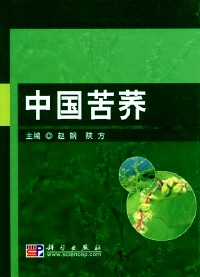简介
本书主要对苦荞的生物学特征、起源分布与进化、种植资源及遗传育
种、高产栽培技术、主要营养及活性成分、苦荞黄酮的提取、分离及鉴定
、药理及临床研究、传统食品、营养及保健食品开发进行了全面的阐述。
本书可供苦荞专业研究工作者,高等院校有关专业教师、研究生、本
科生以及农业、食品工业、医药保健品业技术人员及管理人员参考。
目录
目录
序
前言
第一章 苦荞概述
第一节 苦荞生产的重要意义
第二节 中国苦荞的分布与生产
第三节 苦荞的开发与应用
参考文献
第二章 苦荞的生物学特性
第一节 苦荞的根
第二节 苦荞的茎
第三节 苦荞的叶
第四节 苦荞的花和花序
第五节 苦荞的果实
第六节 苦荞的花粉粒
第七节 苦荞的生长发育
参考文献
第三章 苦荞的起源进化与分布
第一节 苦荞的分类地位
第二节 苦荞的起源、进化与传播
第三节 中国苦荞的分布
参考文献
第四章 苦荞种质资源与遗传育种
第一节 中国苦荞种质资源的搜集、整理和保存
第二节 苦荞的优异种质资源
第三节 苦荞的细胞遗传学基础
第四节 苦荞的同工酶
第五节 苦荞遗传育种
第六节 苦荞的良种繁育
参考文献
第五章 苦荞栽培技术
第一节 苦荞的种植制度
第二节 苦荞田的土壤耕作与整地
第三节 苦荞地施肥
第四节 苦荞的播种技术
第五节 苦荞的合理密植
第六节 苦荞的田间管理
第七节 苦荞收获与储存
第八节 苦荞绿色有机种植技术
参考文献
第六章 苦荞营养保健活性成分
第一节 苦荞的营养学评价
第二节 蛋白质与多肽
第三节 酚类与生物黄酮
第四节 荞麦糖醇
参考文献
第七章 苦荞黄酮的分离与研究
第一节 苦荞生物黄酮的化学组成及其理化性质
第二节 苦荞生物黄酮的提取方法
第三节 苦荞麦生物黄酮的分离与纯化方法
第四节 苦荞黄酮浸出液的浓缩与干燥
第五节 苦荞生物黄酮的定性、定量检查与结构鉴定
第六节 黄酮类化合物的吸收、分布和代谢
第七节 苦荞黄酮应用举例
参考文献
第八章 苦荞药理及临床研究
第一节 苦荞药用成分及药理作用
第二节 苦荞临床研究
第三节 苦荞食疗及验方
参考文献
第九章 苦荞营养保健食品生产与开发
第一节 苦荞传统食品加工工艺
第二节 苦荞新型食品的生产与开发
第三节 苦荞产品的发展趋势
参考文献
Foreword
Preface
Chapter One: Basic Concepts on Tartary Buckwheat
1. The Significance of Tartary Buckwheat Production
2. Distribution and Production of Chinese Tartary Buckwheat
3. Exploitation and Application
References
Chapter Two: Tartary Buckwheat’s Biological Characteristics
1. Root
2. Stem
3. Leaf
4. Flower and Inflorescence
5. Fructification
6. Pollen Grain
7. Growth and Development
References
Chapter Three: The Origin,Distribution and Evolution of Tartary Buckwheat
1. Taxonomy Position
2. Origin,Evolution and Propagation
3. Distribution and Ecosystem
References
Chapter Four: Germplasm Resources and Hereditary Breeding of Tartary Buckwheat
1. Collection,Categorization and Preserve of Chinese Tartary Buckwheat Germplasm Resources
2. Essential Tartary Buckwheat Germplasm Resources
3. Cytogenetics
4. Isoenzyme
5. Hereditary Breeding
6. Stock Breeding
References
Chapter Five: High Yield Cultivation Techniques on Tartary Buckwheat
1. Crop Rotation System
2. Tilth and Land Preparation
3. Manuring Techniques
4. Sowing
5. Reasonable Thick Planting
6. Pest and Disease Control
7. Harvest and Preserve
8. Organic and Green Cultivation Techniques of Tartary Buckwheat
References
Chapter Six: Nutrients and Health Ingredients in Tartary Buckwheat
1. Nutriology Evaluation
2. Proteins and Polypeptide
3. Phenols and Bioflavonoids
4. D-chiro-Inositol and Fagopyritols
References
Chapter Seven: Extraction,Isolation and Identification of Tartary Buckwheat Flavonoids
1. Chemical Composition and Physico-chemistry Properties
2. Extraction Methods
3. Isolation and Purification Methods
4. Concentration and Drying of Flavonoids Extracts
5. Qualitative/Quantitative Examination and Structure Identification
6. Absorption,Distribution and Metabolism of Flavonoids
7. Examples in Tartary Buckwheat Flavonoid Application
References
Chapter Eight: Pharmacology and Clinical Researches on Tartary Buckwheat
1. Pharmaceutical Components and Pharmacologic Actions
2. Clinical Researches
3. Food Therapy and Empirical Prescriptions
References
Chapter Nine: Tartary Buckwheat Nutrition Food and Health Care Products
1. Manufacture of Traditional Tartary Buckwheat Food
2. Production and Development of New Type Tartary Buckwheat Food
3. Trends in Tartary Buckwheat Products Development
References
序
前言
第一章 苦荞概述
第一节 苦荞生产的重要意义
第二节 中国苦荞的分布与生产
第三节 苦荞的开发与应用
参考文献
第二章 苦荞的生物学特性
第一节 苦荞的根
第二节 苦荞的茎
第三节 苦荞的叶
第四节 苦荞的花和花序
第五节 苦荞的果实
第六节 苦荞的花粉粒
第七节 苦荞的生长发育
参考文献
第三章 苦荞的起源进化与分布
第一节 苦荞的分类地位
第二节 苦荞的起源、进化与传播
第三节 中国苦荞的分布
参考文献
第四章 苦荞种质资源与遗传育种
第一节 中国苦荞种质资源的搜集、整理和保存
第二节 苦荞的优异种质资源
第三节 苦荞的细胞遗传学基础
第四节 苦荞的同工酶
第五节 苦荞遗传育种
第六节 苦荞的良种繁育
参考文献
第五章 苦荞栽培技术
第一节 苦荞的种植制度
第二节 苦荞田的土壤耕作与整地
第三节 苦荞地施肥
第四节 苦荞的播种技术
第五节 苦荞的合理密植
第六节 苦荞的田间管理
第七节 苦荞收获与储存
第八节 苦荞绿色有机种植技术
参考文献
第六章 苦荞营养保健活性成分
第一节 苦荞的营养学评价
第二节 蛋白质与多肽
第三节 酚类与生物黄酮
第四节 荞麦糖醇
参考文献
第七章 苦荞黄酮的分离与研究
第一节 苦荞生物黄酮的化学组成及其理化性质
第二节 苦荞生物黄酮的提取方法
第三节 苦荞麦生物黄酮的分离与纯化方法
第四节 苦荞黄酮浸出液的浓缩与干燥
第五节 苦荞生物黄酮的定性、定量检查与结构鉴定
第六节 黄酮类化合物的吸收、分布和代谢
第七节 苦荞黄酮应用举例
参考文献
第八章 苦荞药理及临床研究
第一节 苦荞药用成分及药理作用
第二节 苦荞临床研究
第三节 苦荞食疗及验方
参考文献
第九章 苦荞营养保健食品生产与开发
第一节 苦荞传统食品加工工艺
第二节 苦荞新型食品的生产与开发
第三节 苦荞产品的发展趋势
参考文献
Foreword
Preface
Chapter One: Basic Concepts on Tartary Buckwheat
1. The Significance of Tartary Buckwheat Production
2. Distribution and Production of Chinese Tartary Buckwheat
3. Exploitation and Application
References
Chapter Two: Tartary Buckwheat’s Biological Characteristics
1. Root
2. Stem
3. Leaf
4. Flower and Inflorescence
5. Fructification
6. Pollen Grain
7. Growth and Development
References
Chapter Three: The Origin,Distribution and Evolution of Tartary Buckwheat
1. Taxonomy Position
2. Origin,Evolution and Propagation
3. Distribution and Ecosystem
References
Chapter Four: Germplasm Resources and Hereditary Breeding of Tartary Buckwheat
1. Collection,Categorization and Preserve of Chinese Tartary Buckwheat Germplasm Resources
2. Essential Tartary Buckwheat Germplasm Resources
3. Cytogenetics
4. Isoenzyme
5. Hereditary Breeding
6. Stock Breeding
References
Chapter Five: High Yield Cultivation Techniques on Tartary Buckwheat
1. Crop Rotation System
2. Tilth and Land Preparation
3. Manuring Techniques
4. Sowing
5. Reasonable Thick Planting
6. Pest and Disease Control
7. Harvest and Preserve
8. Organic and Green Cultivation Techniques of Tartary Buckwheat
References
Chapter Six: Nutrients and Health Ingredients in Tartary Buckwheat
1. Nutriology Evaluation
2. Proteins and Polypeptide
3. Phenols and Bioflavonoids
4. D-chiro-Inositol and Fagopyritols
References
Chapter Seven: Extraction,Isolation and Identification of Tartary Buckwheat Flavonoids
1. Chemical Composition and Physico-chemistry Properties
2. Extraction Methods
3. Isolation and Purification Methods
4. Concentration and Drying of Flavonoids Extracts
5. Qualitative/Quantitative Examination and Structure Identification
6. Absorption,Distribution and Metabolism of Flavonoids
7. Examples in Tartary Buckwheat Flavonoid Application
References
Chapter Eight: Pharmacology and Clinical Researches on Tartary Buckwheat
1. Pharmaceutical Components and Pharmacologic Actions
2. Clinical Researches
3. Food Therapy and Empirical Prescriptions
References
Chapter Nine: Tartary Buckwheat Nutrition Food and Health Care Products
1. Manufacture of Traditional Tartary Buckwheat Food
2. Production and Development of New Type Tartary Buckwheat Food
3. Trends in Tartary Buckwheat Products Development
References
中国苦荞
- 名称
- 类型
- 大小
光盘服务联系方式: 020-38250260 客服QQ:4006604884
云图客服:
用户发送的提问,这种方式就需要有位在线客服来回答用户的问题,这种 就属于对话式的,问题是这种提问是否需要用户登录才能提问
Video Player
×
Audio Player
×
pdf Player
×



